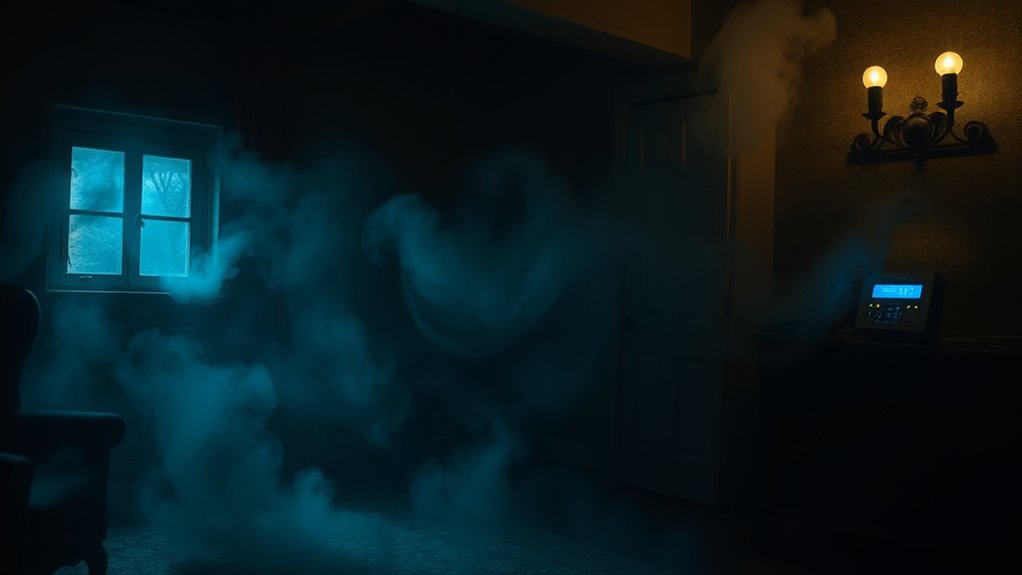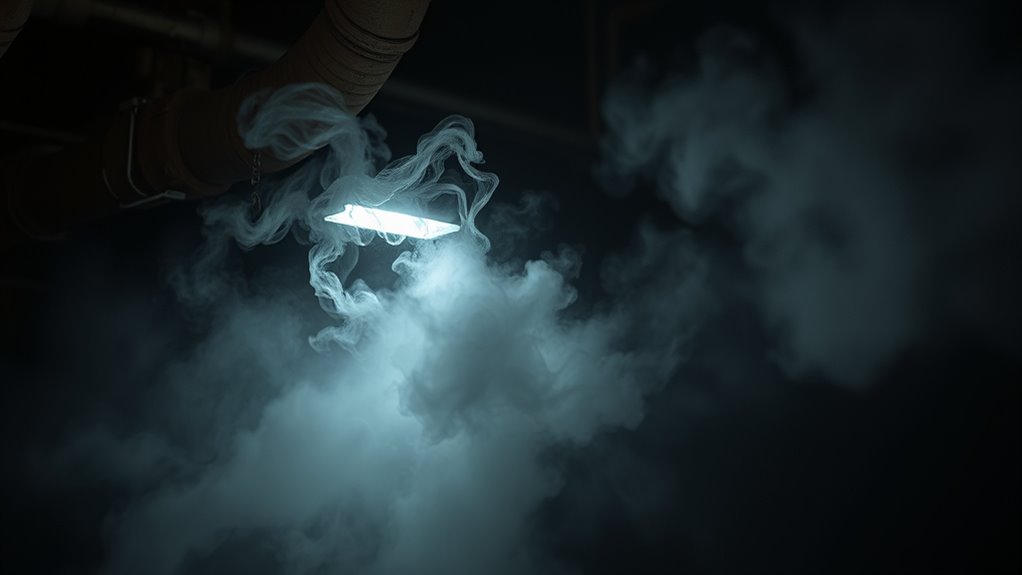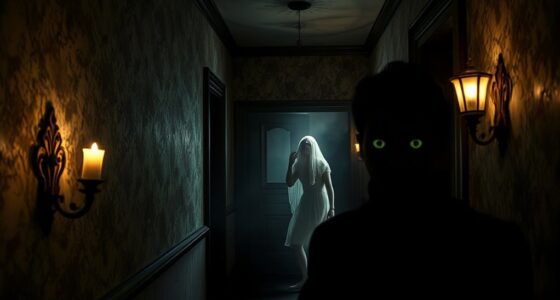Carbon monoxide poisoning can cause symptoms like hallucinations, dizziness, and strange sensations, which often mimic ghost sightings or hauntings. When exposed, your body’s oxygen transport is impaired, leading to physiological reactions that might be mistaken for paranormal activity. Using tools like gas detectors and spectral analysis helps identify CO levels accurately. Understanding these science-based explanations can reveal the real cause behind many haunting reports—if you look closer, there’s more to discover.
Key Takeaways
- Symptoms of carbon monoxide poisoning, like hallucinations and dizziness, can mimic paranormal experiences such as ghost sightings.
- CO binds to hemoglobin more effectively than oxygen, causing hypoxia that may lead to visual and sensory disturbances.
- Gas detection devices and spectral analysis can objectively identify elevated CO levels in environments linked to haunting reports.
- Scientific techniques confirm whether reported hauntings are due to physiological effects of CO rather than supernatural causes.
- Recognizing CO poisoning symptoms helps prevent health risks, clarifies false paranormal claims, and promotes safety in suspected locations.

Many haunting reports and ghost sightings may actually have a scientific explanation rooted in carbon monoxide poisoning. When people experience strange sensations, hallucinations, or feelings of an unseen presence, it’s easy to attribute these to supernatural causes. However, subtle symptoms caused by carbon monoxide exposure can mimic those of psychological distress or fear, leading individuals to interpret their experiences as paranormal encounters. Understanding how this colorless, odorless gas affects the body is *essential* for recognizing when these phenomena are rooted in a physiological response rather than supernatural activity.
One key to unraveling these illusions lies in effective gas detection. Carbon monoxide binds to hemoglobin in your blood more readily than oxygen does, impairing oxygen transport and causing hypoxia—an oxygen deficiency in tissues. This can lead to symptoms like dizziness, confusion, visual disturbances, and hallucinations. When these symptoms occur in a haunted house, occupants might perceive a ghostly presence or feel a chilling sensation, which they then interpret as supernatural. To prevent misdiagnosis, proper gas detection methods are *indispensable*. Portable sensors and detectors can identify elevated carbon monoxide levels quickly, alerting residents before symptoms worsen or false experiences occur.
Spectral analysis plays a *crucial* role in understanding and confirming the presence of carbon monoxide in such cases. This scientific technique involves examining the specific wavelengths of light absorbed or emitted by gases, allowing experts to identify and quantify carbon monoxide with high accuracy. By analyzing the spectral signatures of the gases present, investigators can determine if elevated levels of carbon monoxide are responsible for the symptoms reported during supposed hauntings. This method provides a clear, objective basis for distinguishing between genuine paranormal activity and physiological effects caused by poisoning.
The combination of gas detection technology and spectral analysis helps demystify many reports of haunted locations. When symptoms align with elevated carbon monoxide levels detected by sensors, and spectral analysis confirms the presence of the gas, it becomes evident that what seemed like ghostly encounters had a scientific explanation. This knowledge is *indispensable* not just for solving mysteries but also for safeguarding health. Recognizing the signs of carbon monoxide poisoning and understanding the tools used for detection can prevent tragedy and dispel illusions rooted in physiological responses rather than supernatural phenomena.
In essence, many of the eerie stories and ghost sightings that persist in folklore and popular culture can be explained through science. By focusing on gas detection and spectral analysis, you can uncover the truth behind these reports, ensuring that what appears to be a haunting is properly identified as a health hazard instead of a paranormal event. Additionally, increasing awareness about carbon monoxide symptoms can help individuals seek prompt medical attention and avoid serious health consequences.
Frequently Asked Questions
Can Carbon Monoxide Exposure Cause Hallucinations?
Yes, carbon monoxide exposure can cause hallucinations. When indoor air quality drops due to toxic exposure, your brain doesn’t get enough oxygen, leading to symptoms like dizziness, confusion, and hallucinations. If you notice these signs, it’s vital to leave the area immediately and seek medical help. Preventing such exposure involves ensuring proper ventilation and regular maintenance of heating systems to avoid dangerous levels of carbon monoxide.
Are There Specific Times When Hauntings Are More Likely Linked to CO Poisoning?
Hauntings linked to CO poisoning often occur during seasonal patterns, much like how certain plants bloom at specific times. You’re more likely to notice these during colder months when heating systems may malfunction, especially in geographic hotspots with older infrastructure. During these times, symptoms like hallucinations or strange experiences can be mistaken for hauntings, making it essential to check your heating and ventilation systems for leaks to stay safe.
How Do CO Levels Fluctuate During Ghostly Encounters?
During ghostly encounters, CO levels can fluctuate due to environmental factors like poor ventilation or the presence of appliances that produce carbon monoxide. Sensor readings might spike unexpectedly, especially in enclosed spaces or areas with blocked vents. You should be aware that these fluctuations are often linked to changes in airflow or new sources of CO, which can create the illusion of paranormal activity. Always prioritize safety and get tested if you suspect CO presence.
Is There a Psychological Component to Co-Related Haunting Reports?
Imagine a Victorian séance, where psychological effects and cognitive distortions can make you more prone to believing in hauntings. Yes, there’s a psychological component to CO-related haunting reports. When exposed to low levels of carbon monoxide, your mind may interpret symptoms like dizziness or hallucinations as supernatural encounters. This creates a feedback loop, reinforcing the belief in spirits, even though it’s rooted in real physiological effects.
Can CO Poisoning Mimic Supernatural Experiences?
Yes, carbon monoxide poisoning can mimic supernatural experiences. Historical cases show victims often report hallucinations and eerie sensations, which are then interpreted through cultural lenses as ghostly encounters. You might experience vivid visions or feelings of presence, leading you to believe in hauntings. These symptoms are caused by CO’s effects on your brain, making it important to contemplate poisoning as a possible explanation before jumping to supernatural conclusions.
Conclusion
So, next time you hear strange noises or feel uneasy in your home, remember—it could be more than just ghosts. Carbon monoxide poisoning can create haunting illusions so convincing, you’ll swear spirits are lurking. Don’t dismiss these signs as mere superstition; your life might depend on recognizing the deadly truth behind the scares. Stay vigilant, and always check your carbon monoxide levels—because what feels like a haunting could actually be a silent killer waiting to strike.









